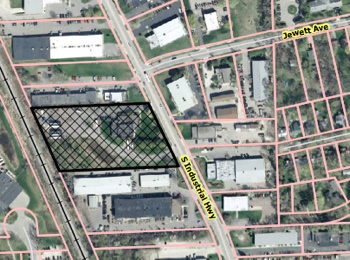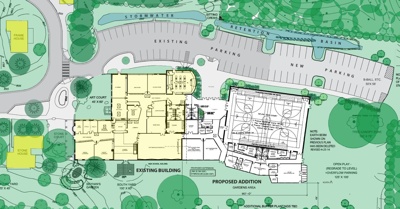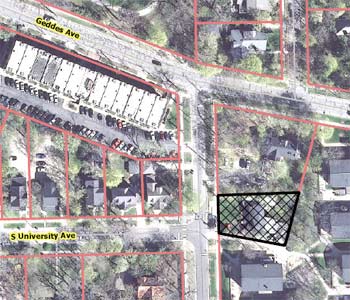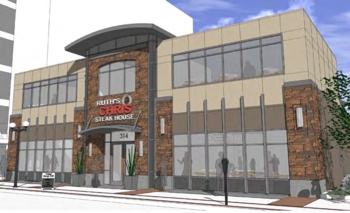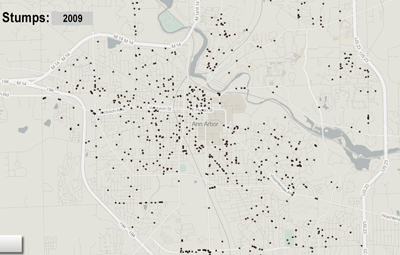A controversial request to allow up to six Jesuits to live together at 1919 Wayne St. did not secure sufficient votes for approval from Ann Arbor planning commissioners at their June 3, 2014 meeting, following about an hour of public commentary and two hours of deliberations.
However, at the end of the meeting – near midnight – commissioners voted to reconsider the item, and then subsequently voted to postpone action until their next meeting on June 17.
The request – by the Ann Arbor Jesuit Community, formally known as the USA Midwest Province of the Society of Jesus – is for a special exception use to allow a “functional family” to live in a house zoned R1C (single-family dwelling). Without the special exception use, up to four unrelated people could live there.
The code that allows this special exception use was adopted in 1991, but this is the first time any group has requested it. The members are affiliated with the St. Mary Student Parish.
Approval required six votes, but the request initially garnered support from only five of the seven commissioners who were present. Voting against it were Diane Giannola and Kirk Westphal. Two commissioners – Sabra Briere and Paras Parekh – were absent. An attempt earlier in the meeting to postpone the vote had failed, with a majority of commissioners wanting to take action that night, assuming it would pass. The final vote to postpone – taken after all other agenda items were dispatched – was 6-1, over dissent from Giannola.
The six unrelated members of the household are considered a “functional family” for purposes of the city’s zoning code, defined as follows: “a group of people plus their offspring, having a relationship which is functionally equivalent to a family. The relationship must be of a permanent and distinct character with a demonstrable and recognizable bond characteristic of a cohesive unit.” The residents would be members of the religious order at St. Mary’s Student Parish, or pursuing degrees at the University of Michigan or other local institutions.
The group’s application describes how the Jesuits live as a “functional family.” The statement reads, in part:
As a functional family, we refer to one another, when speaking of each other collectively, as “brothers.” Our unity is based upon our religious commitment to live together as a religious family. As brothers related to one another by our common vows and commitment to service in the Church, we are, like a family, one another’s primary support system.
…
The basis of our living as a household is not temporary or dependent on the University school year or any such seasonal arrangement or pattern, as a fraternity or sorority would typically be. Jesuits living in structured households under a superior has been an integral part of the religious order for centuries, and the Jesuits who will live at 1919 Wayne will be participating in that centuries old tradition.
Wayne Street is located on the city’s near east side, between Washtenaw Avenue and Vinewood Boulevard, in Ward 2.
No exterior changes are planned to the structure of the house, which has about 4,000 square feet with seven bedrooms and two bathrooms. The Jesuits indicated that they’d like to reconfigure the interior to use one of the bedrooms as a guest room and to add two bathrooms.
The special exception use would be contingent on providing off-street parking spaces for each vehicle used by the residents. [.pdf of staff memo]
During the project’s public hearing, 21 people spoke – the majority of them opposed to the request, including representatives from the Oxbridge Neighborhood Association and the North Burns Park Association. Concerns included the possibility of lower property values, the chance of opening the door to student housing or cults, instability of the household because members aren’t related, and “gender housing discrimination.”
Some people directed criticism against the power, privilege and abuse of the Catholic church. Other praised the Jesuits, saying their concerns were strictly related to the zoning code, which they didn’t feel permitted this type of living arrangement in the R1C district. They suggested that the Jesuits could live in other districts – like R4C – that would allow for up to six unrelated people to live together without getting a special exception use.
Three Jesuits who plan to live there – including Ben Hawley, pastor and director of campus ministry for the St. Mary Student Parish – attended the meeting. Rev. Daniel Reim, who serves as the head of household, apologized for the controversy that this request has caused. The group currently lives in a smaller house on Ferdon, which they said they’ve outgrown. Some supporters of the request noted how the men are good neighbors on Ferdon. The former owner of that house noted that nearby properties he’s built or renovated had sold for over $1 million, saying that the argument about hurting property values was “silly.”
Giannola voted against the request, saying she didn’t think the Jesuits fit the description of a “functional family.” Westphal said he wanted to get more information from the city attorney’s office about the risk of setting a precedent, and whether there could be conditions on the special exception use that would address concerns about the turnover of residents. Planning staff reported that the city attorney’s office had already vetted the item, but they will now make additional queries based on commissioners’ feedback.
There’s some question about whether a delay will affect the sales contract that the Jesuits have with the current owner, who also attended the meeting. Planning manager Wendy Rampson said she’d contact them on Wednesday morning to communicate the commission’s action.
The public hearing will be re-opened on June 17, to allow for additional public input.
One additional wrinkle at that meeting will be the composition of the commission. Two commissioners who supported the request – Jeremy Peters and Eleanore Adenekan – will be absent, and another supporter, Ken Clein, indicated that he might also be unable to attend. So it’s possible that there will only be six commissioners at that meeting – which means all commissioners would need to vote yes in order for it to pass.
The planning commission has discretion to grant a special exception use, which does not require additional city council approval.
One of the Ward 2 city councilmembers, Jane Lumm, attended the planning commission meeting, but did not formally address the commission. Westphal – the planning commission’s chair – is running for city council in the Ward 2 Democratic primary against Nancy Kaplan.
This brief was filed from the second-floor council chambers at city hall, located at 301 E. Huron. A more detailed report will follow: [link]




